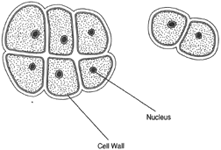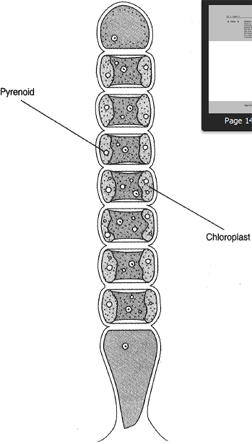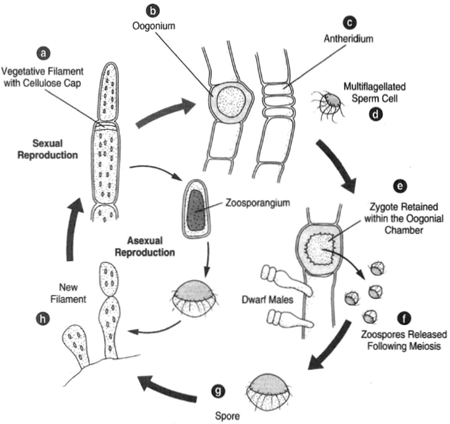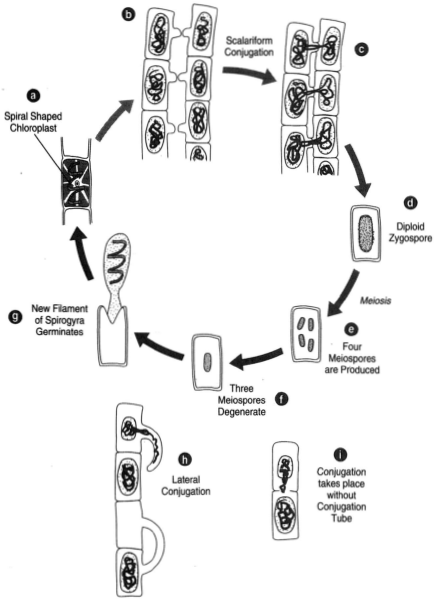The Tetrasporine Line
In the Tetrasporine line, the cells are uninucleated and primarily nonmotile. If motile cells do occur, they do so only during reproductive phases. Cells in the Tetrasporine line of green alga grow in filaments or sheets. Pleurococcus, Ulothrix, Oedogonium, Spirogyra, and Ulva are several examples of this line.Pleurococcus
Pleurococcus (protococcus) is perhaps the most abundant algal cell in the world. Boy Scouts use the knowledge that this alga grows on the north sides of tree trunks to find their way out of the woods! Pleurococcus appears to wide only mitosis, forming small clusters of cells. The cells are quite like those of Chlamydomonas but without flagella.
 |
| Figure 13-5 Pleurococcus |
 |
| Figure 13-6 Ulothrix |
Ulothrix
Ulothrix is a filamentous green alga, the cells of which each have a nucleus surrounded by a girdle-shaped chloroplast. The filaments may be found attached by a basal cell to a rock or other substrate in cold, running water. The cells reproduce mitotically to increase the length of the chain. Ulothrix cells produce four to eight zoospores, and eac zoospore bears four flagella for a time before settling onto a substrate and undergoing divisions to form a new filament. The cells that give rise to the zoospores are called sporangi. or zoosporangia. Isogametes are also produced in cells called gametangia. At Notes At Each such gamete possesses two flagella rather than four. Gametes from different filaments come together to form zygotes (Ulothrix being heterothallic). The zygotes are thus temporarily four flagellated. When the zygotes germinate, they become either motile or nonmotile spores. The spores, in turn, grow into new filaments. The zygotes have thick, resistant walls that enable the cells to withstand adverse conditions such as winter weather.
Ulothrix exhibits a form of cell differentiation in that the basal cell, or holdfast, functions in a way different from that of the other cells. Rootlike extrusions that extend from the basal cell attach to rock or some other substrate. In contrast with the colonial arrangement, this suggests the beginning of a multicellular individual.
Oedogonium
Oedogonium is another filamentous, uninucleated green alga of the Tetrasporine line. The filament of Oedogonium has a specialized basal cell called a holdfast. The chloroplasts of the vegetative cells are netlike, taking the shape of tubes and surrounding the protoplasts. There are several pyrenoids. This form is found in lakes, slow-moving streams, and stagnant water. More than 250 species have been described, approximately one-half of which occur in the United States.
When cells divide to increase the length of the filament, a specialized process takes place at the distal end of the cell (the end opposite the attached end of the filament). This process results in a band, or a thickening of the wall, called a cap.
Both asexual and sexual methods of reproduction occur in Oedogonium. The most conspicuous cell in a filament is the one that forms the zoospore. The entire contents of the cell become round and develop a circle of cilia. When the cell wall breaks open, the zoospore swims around before settling down and growing into a new filament of Oedogonium. The cell containing the zoospore will regularly break open at the place where the cap occurs (that is, at the distal end of the cell).
Sexual reproduction in Oedogonium is heterogamous; both eggs and sperms are produced. Certain cells become oogonia, or bearers of eggs. These cells enlarge, their contents becoming round, and each produces a single, nonmotile egg cell. The egg is thus contained within the cell wall and within the oogonium. A small hole in the oogonial wall allows the entrance of a sperm cell.
The sperm cell is produced in a special cell called the antheridium. Antheridial cells are small, and two sperm cells are produced in each cell. The sperm cells are ciliated and, when released, swim toward the oogonium. A chemical attractant secreted by the oogonial wall induces the sperm to swim in the proper direction. One of the sperms may enter the oogonium through the opening and fertilize the egg. When fertilization occurs, the opening in the oogonial wall closes, and the zygote develops a resistant covering. The zygote thus can resist harsh conditions for a period of months. Note that the zygote is the only diploid cell that occurs in Oedogonium. When germination occurs, meiosis takes place, and four haploid zoospores are formed. These grow into new Oedogonia.
Before proceeding, considert hat reproduction was initially accomplished solely by fission; that, in time, asexual reproduction was accomplished by spores; that there then came isogamous followed by heterogamous sexual re production; and that then the sexes became inherent in different individuals.
An important development among Oedogonium is the evolution of minute male plants that can attach to the cells adjacent to oogonia. These dwarf males occupy positions of opportunity; the sperm cells they produce need travel a minimal distance in order to accomplish their mission (see figure 13-7).
 |
| Figure 13-7 Oedogonium (a) vegetative filament with cellulose cap; (b) filament with oogonium bearing an egg; (c) filament with antheridia; (d) multiflagellated sperm cell; (e) a zygote retained within the oogonial chamber. When the zygote germinates, meiosis occurs, producing zoospores, (f ) Dwarf males grow closet o an oogonium. Asexual reproduction is shown in the smaller circle. |
Spirogyra
The handsome, spiral-shaped chloroplasts of Spirogyra always seem to bring a stir of elation to botanists. Spirogyra occurs in long filaments of cells, the chloroplasts of which hug the inside surface of the cell membrane. The centrally placed nucleus is held in position by strands of cytoplasm. The chloroplasts have numerous pyrenoids. Depending on one’s taste for names, Spirogyra has been labeled both “Mermaids Tresses” and “Frog Spit.” The filaments have a gelatinous sheath, which lends them a slimy feel. There are approximately sixty-five species of Spirogyra in the United States. Various forms grow in shallow ponds, slow-moving water, or in stagnant pools.
Asexual reproduction in Spirogyra is achieved by fragmentation of the chain of cells, which may result from changes in temperature or acidity or from mechanical means. Although there are male and female protoplasts, sexual reproduction is isogamous. When physiologically different filaments come to lie side by side and parallel to one another, small protuberances grow on the surfaces of the cells on the sides facing the neighboring filament (see figure 13-8b and c). The protuberances of the adjacent filaments extend outward and come in contact. The walls at the point of contact then break down, and a bridge between neighboring cells (called a conjugation tube) forms. Because the appearance of the two filaments at this moment is like a ladder, the event is called scalariform (ladderlike) conjugation. All the protoplasts up and down the line then become round, and those of one filament move across the bridges virtually in unison to fuse with the protoplasts of adjacent cells, thus forming zygotes. The movement is said to be amoeboid. In that they move, the protoplasts of one filament thus behave as sperm cells; and in that they remain in place, the protoplasts of the other filament take on the role of eggs. Because the bulk of the receiving cell doubles, this process must be accompanied by the expulsion of water. This is achieved by contractile vacuoles.
As in Oedogonium, a diploid zygote forms. The zygote secretes a thick wall and may remain dormant for some time. Upon germination, meiotic division results in the formation of four haploid spores. But at this point, something happens: three of the four spores always degenerate and disappear, leaving only one that can grow into a new spirogyra plant. This is of particular significance in that this event occurs in higher plants. Unlike other genera thus far discussed, the Spirogyra spore is nonmotile.
 |
| Figure 13-8 Spyrogyra (a) the spiral-shaped chloroplast, within the cell. (b) and (c) show scalariform conjugation. Two filaments of cells come to lie parallel with end walls precisely aligned. Outgrowths of each cell extend medially, make contact, and produce bridges over which the entire protoplast of a cell can migrate to the neighbor. In this manner, a diploid zygospore, (d), is produced. (e) Meiosis within the spore wall follows. There for the four meiospores degenerate and disappear leaving one (f) to germinate and produce a new filament of Spirogyra, (g). (h) Another form of conjugation known as lateral conjugation. A protoplast moves downward to a neighboring cell below, leaving every alternate cell empty. (i) Conjugation takes place without the formation of a conjugation tube and by the protoplast moving through the cell end wall. |
Spirogyra also exhibits another, less frequently seen kind of conjugation. This form of conjugation occurs between adjacent cells of the same filament (see figure 13-8h and i). A cell produces a conjugation tube, but, having no neighboring filament to which to reach out, the tube instead grows downward to the next cell below. The protoplast then moves down to form a zygote. This is called lateral conjugation. It is readily apparent that in scalariform conjugation, one filament becomes entirely empty of cell contents, whereas in lateral conjugation, every alternate cell becomes empty.
Sometimes, the cells of a spirogyra begin the process of gamete formation (getting ready for sexual union), but the process is halted, and no fusion occurs. We may think of this as an egg being denied fusion with a sperm. The egg cell, however, is still capable of growing into a new spirogyra. The production of a new individual by an egg cell without that egg cell being fertilized by a sperm cell is called parthenogenesis.
Ulva
Thus far in our discussion of the Tetrasporine line, we have examined algae that grow only in single filaments. Ulva, or sea lettuce, grows in broad sheets. Consider how this can occur. If the orientation of the mitotic spindle were always the same as a cell goes through divisions, the result would be a single line of cells-a uniseriate filament. If, however, the spindle were to shift at right angles to the previously described position, a thin sheet of cells would result a sheet one cell thick. This scenario occurs in the green alga Monostroma. If the cells in such a sheet were to change the polarity of the mitotic spindle, the result could be a sheet two cells in thickness. Such is the case with Ulva. When Ulva begins its growth from a single cell, the beginning divisions produce a filament. Soon, however, the orientation of the spindle shifts to a second and then a third plane, thus producing a broad thallus of two layers of cells.
In Ulva, asexual reproduction by spores and sexual reproduction by gametes alternates with the passing generations. The plant that produces gametes is the gametophyte, and the plant that forms spores is the sporophyte. Thus, in the alternation of generations, the gametophyte generation is followed by a sporophyte generation, and the sporophyte generation then produces the next gametophyte generation (see figure 13-9). The gametophyte plants and sporophyte plants look alike but produce different things.
In the gametophyte generation, the sexes are separate: a male thallus and a female thallus (or, if the species is isogamous, plus and minus). Many cells function as gametangia, producing biflagellated gametes. These gametes fuse in pairs. The members of each pair come from different thalli, and their fusion produces a zygote. The zygote then grows into a new thallus that looks the same as the gametophyte plant. Because the divisions of the zygote are mitotic, however, the new thallus is diploid (2N). This plant is a sporophyte. It produces quadriflagellated zoospores in sporangia. Meiosis then occurs, and the zoospores are haploid (1N). The zoospores must be of two sorts because some of them produce male gametophytes and some produce female gametophytes. Whereas the gametophyte generation is haploid, then, the sporophyte generation is diploid. And whereas gametes are produced by mitosis, spores are produced by meiosis. Because the two generations look alike, this can be referred to as alternation of isomorphic generations. Alternation of generations, though not of isomorphic generations, is the universal condition in higher plants.
 |
| Figure 13-9 Ulva, showing alternation of isomorphic generations: (a) A 2N sporophyte that produces quadriflagellated zoospores by meiosis; (b)sporophytes in cross section. Sporophytes are of two sorts, producing male gametophytes, (c) and (d), or female gametophytes, (e) and (f). The gametes, (g), unite (h), and produce the next sporophyte generation, (i). |




